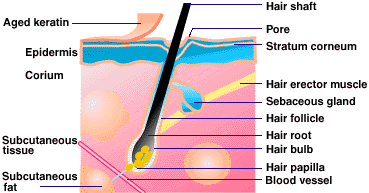The Structure of Your Hair
Scientists claim that human beings will increasingly loose their hair, resulting in a totally naked being. Many hundred years have however to pass by until this awful prophecy will become true. Until then we have enough time to study and understand the life of hair.
Hair is actually dead material when it leaves it's root - otherwise it would hurt very much when your hairdresser works with his scissor. Most people know about this fact, but did you know about other facts: On a normal scalp there are about 100-150 thousand hair fibers. A blonde head of hair has usually much more fibers than red or dark haired heads. Hair consists mainly of keratin, which is also responsible for the elasticity of fingernails. A single hair has a thickness of 0.02-0.04mm, so that 20-50 hair fibers next to each other make one millimeter. Hair is strong as a wire of iron. It rips after applying a force equivalent to 60kg, after it stretched itself for about 70%.
The root of a hair fiber sticks in a bag in the skin. The fiber is pushed out of this bag about 0.35mm per day, making an average growth rate of 1cm, or half of an inch, per month. The growth rate is however very much related to the individual person, his age, his diet etc.
Healthy hair has an average lifetime of 2-6 years. After a rest period of three months the single hair falls out, and a new fiber starts to grow out of the bag. The lifetime depends on circumstances and person, too. The lifetime of hair is responsible for the maximum of hair length you can have. Waist length hair takes about 6 years to grow out from a short hair cut, periodic trims included. If your hair has a lifecyle of 2 years, you will never achieve a nice waist length mane.
So now how do we correct the problems? First, let's start by solving concerns
BEFORE they start. Everyone ought to have:
hair, hair, hair, hair, hair, hair, hair, hair, hair, hair, hair, hair, hair, hair, hair, hair, hair, hair, hair, hair, hair, hair, hair, hair, hair, hair, hair, hair, hair, hair, hair, hair, hair, hair, hair, hair, hair, hair, hair, hair, hair, hair, hair, hair, hair, hair, hair, hair, hair, hair, hair, hair, hair, hair, hair, hair, hair, hair, hair, hair, hair, hair, hair, hair, hair, hair, hair, hair, hair, hair, hair, hair, hair, hair, hair, hair, hair, hair, hair, hair, hair, hair, hair, hair, hair, hair, hair, hair, hair, hair, hair, hair, hair, hair, hair, hair, hair, hair, hair, hair, hair, hair, hair, hair, hair, hair, hair, hair, hair, hair, hair, hair, hair, hair, hair, hair, hair, hair, hair, hair, hair, hair, hair, hair, hair, hair, hair, hair, hair, hair, hair, hair, hair, hair, hair, hair, hair, hair, hair, hair, hair, hair, hair, hair, hair, hair, hair, hair, hair, hair, hair, hair, hair, hair, hair, hair, hair, hair, hair, hair, hair, hair, hair, hair, hair, hair, hair, hair, hair, hair, hair, hair, hair, hair, hair, hair, hair, hair, hair, hair, hair, hair, hair, hair, hair, hair, hair, hair,